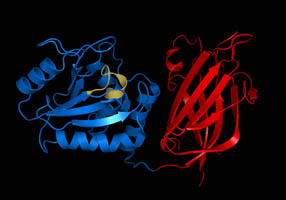
Phosphatase and tensin homolog (PTEN) is a phosphatase in humans and is encoded by the PTEN gene. Mutations of this gene are a step in the development of many cancers, specifically glioblastoma, lung cancer, breast cancer, and prostate cancer. Genes corresponding to PTEN (orthologs) have been identified in most mammals for which complete genome data are available.

Phosphatidylinositol (3,4)-bisphosphate is a minor phospholipid component of cell membranes, yet an important second messenger. The generation of PtdIns(3,4)P2 at the plasma membrane activates a number of important cell signaling pathways.

Oculocerebrorenal syndrome is a rare X-linked recessive disorder characterized by congenital cataracts, hypotonia, intellectual disability, proximal tubular acidosis, aminoaciduria and low-molecular-weight proteinuria. Lowe syndrome can be considered a cause of Fanconi syndrome.

Nephrin is a protein necessary for the proper functioning of the renal filtration barrier. The renal filtration barrier consists of fenestrated endothelial cells, the glomerular basement membrane, and the podocytes of epithelial cells. Nephrin is a transmembrane protein that is a structural component of the slit diaphragm. It is present on the tips of the podocytes as an intricate mesh connecting adjacent foot processes. Nephrin contributes to the strong size selectivity of the slit diaphragm, however, the relative contribution of the slit diaphragm to exclusion of protein by the glomerulus is debated. The extracellular interactions, both homophilic and heterophilic—between nephrin and NEPH1—are not completely understood. In addition to eight immunoglobulin G–like motifs and a fibronectin type 3 repeat, nephrin has a single transmembrane domain and a short intracellular tail. Tyrosine phosphorylation at different sites on the intracellular tail contribute to the regulation of slit diaphragm formation during development and repair in pathology affecting podocytes. Podocin may interact with nephrin to guide it onto lipid rafts in podocytes, requiring the integrity of an arginine residue of nephrin at position 1160.

Dent's disease is a rare X-linked recessive inherited condition that affects the proximal renal tubules of the kidney. It is one cause of Fanconi syndrome, and is characterized by tubular proteinuria, excess calcium in the urine, formation of calcium kidney stones, nephrocalcinosis, and chronic kidney failure.

Collagen alpha-3(IV) chain is a protein that in humans is encoded by the COL4A3 gene.

Multidrug resistance-associated protein 2 (MRP2) also called canalicular multispecific organic anion transporter 1 (cMOAT) or ATP-binding cassette sub-family C member 2 (ABCC2) is a protein that in humans is encoded by the ABCC2 gene.

Myotubularin is a protein that in humans is encoded by the MTM1 gene.

Inversin is a protein that in humans is encoded by the INVS gene.

Bardet–Biedl syndrome 1 protein is a protein that in humans is encoded by the BBS1 gene. BBS1 is part of the BBSome complex, which required for ciliogenesis. Mutations in this gene have been observed in patients with the major form of Bardet–Biedl syndrome.

Type II inositol-1,4,5-trisphosphate 5-phosphatase is an enzyme that in humans is encoded by the INPP5B gene.

Multiple inositol polyphosphate phosphatase 1 is an enzyme that in humans is encoded by the MINPP1 gene.

Inositol polyphosphate 1-phosphatase is an enzyme that, in humans, is encoded by the INPP1 gene. INPP1 encodes the enzyme inositol polyphosphate-1-phosphatase, one of the enzymes involved in phosphatidylinositol signaling pathways. This enzyme removes the phosphate group at position 1 of the inositol ring from the polyphosphates inositol 1,4-bisphosphate and inositol 1,3,4-trisphophosphate.

Putative tyrosine-protein phosphatase TPTE is an enzyme that in humans is encoded by the TPTE gene.

Phosphatidylinositol 4,5-bisphosphate 5-phosphatase A is an enzyme that in humans is encoded by the INPP5J gene.

Ankyrin-2, also known as Ankyrin-B, and Brain ankyrin, is a protein which in humans is encoded by the ANK2 gene. Ankyrin-2 is ubiquitously expressed, but shows high expression in cardiac muscle. Ankyrin-2 plays an essential role in the localization and membrane stabilization of ion transporters and ion channels in cardiomyocytes, as well as in costamere structures. Mutations in ANK2 cause a dominantly-inherited, cardiac arrhythmia syndrome known as long QT syndrome 4 as well as sick sinus syndrome; mutations have also been associated to a lesser degree with hypertrophic cardiomyopathy. Alterations in ankyrin-2 expression levels are observed in human heart failure.

Inositol 1,4,5-trisphosphate receptor, type 3, also known as ITPR3, is a protein which in humans is encoded by the ITPR3 gene. The protein encoded by this gene is both a receptor for inositol triphosphate and a calcium channel.
72 kDa inositol polyphosphate 5-phosphatase, also known as phosphatidylinositol-4,5-bisphosphate 5-phosphatase or Pharbin, is an enzyme that in humans is encoded by the INPP5E gene.

Professor Oliver Murray Wrong was an eminent academic nephrologist and one of the founders of the speciality in the United Kingdom. From a background as a "salt and water" physician, he made detailed clinical observations and scientifically imaginative connections which were the basis of numerous advances in the molecular biology of the human kidney. Wrong himself contributed to much of the molecular work after his own "retirement". He dictated amendments to his final paper during his final illness in his own teaching hospital, University College Hospital (UCH), London. Though academic in his leanings, he was a compassionate physician who established a warm rapport with patients, a link he regarded as the keystone of his research. He belonged to a generation of idealistic young doctors responsible for the establishment of the UK's National Health Service in the post-War years.

Inositol polyphosphate-5-phosphatase F is a protein that in humans is encoded by the INPP5F gene.




















